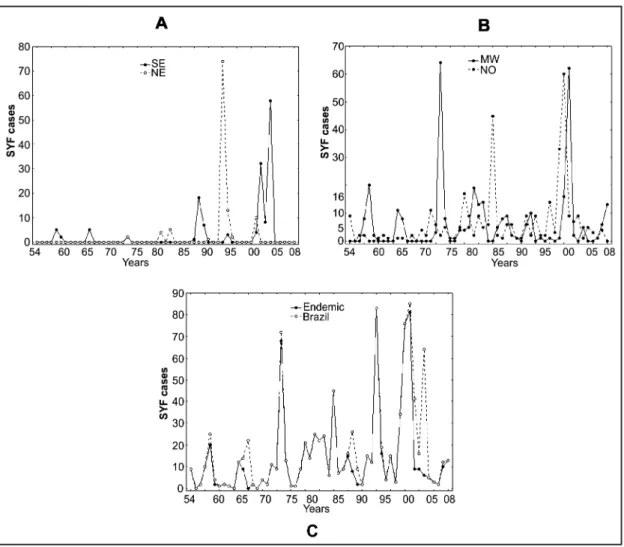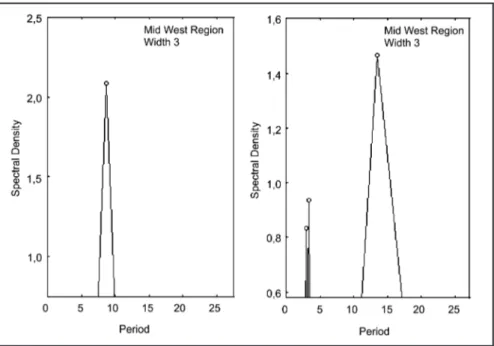297
Revista da Sociedade Brasileira de Medicina Tropical 44(3):297-299, mai-jun, 2011INTRODUCTION
1. Setor de Epidemiologia de Doenças Infecto-Contagiosas, Instituto de Microbiologia, Universidade Federal do Rio de Janeiro, Rio de Janeiro, RJ.
Address to: Dr. Fernando Portela Câmara. SEDI/UFRJ. Rua Pinheiro Machado 25/405, Laranjeiras, 22231-090 Rio de Janeiro, RJ, Brasil.
Phone 55 21 9618-8603 e-mail: portela@micro.ufrj.br Received in 12/08/2010 Accepted in 17/11/2010
Dynamic behavior of sylvatic yellow fever in Brazil (1954-2008)
Comportamento dinâmico da febre amarela silvestre no Brasil (1954-2008)
Fernando Portela Câmara
1, Ana Luisa Bessa Bacellar Gomes
1, Luiz Max Fagundes de Carvalho
1and
Luiz Gustavo Veloso Castello
1ABSTACT
Introduction: Sylvatic yellow fever (SYF) is enzootic in Brazil, causing periodic outbreaks in humans living near forest borders or in rural areas. In this study, the cycling paterns of this arbovirosis were analyzed. Methods: Spectral Fourier analysis was used to capture the periodicity paterns of SYF in time series. Results: SYF outbreaks have not increased in frequency, only in the number of cases. here are two dominant cycles in SYF outbreaks, a seven year cycle for the central-western region and a 14 year cycle for the northern region. Most of the variance was concentrated in the central-western region and dominated the entire endemic region. Conclusions: he seven year cycle is predominant in the endemic region of the disease due the greater contribution of variance in the central-western region; however, it was possible identify a 14 cycle that governs SYF outbreaks in the northern region. No periodicities were identiied for the remaining geographical regions.
Keywords: Sylvatic yellow fever. Periodicity. Spectral analysis. Epidemiology.
RESUMO
Introdução: A febre amarela silvestre (FAS) é enzoótica no Brasil, causando surtos periódicos em humanos que vivem próximos às áreas lorestais ou em áreas rurais. Neste estudo, foram analisados os padrões de periodicidade desta arbovirose. Métodos: Utilizamos a análise espectral de Fourier para capturar os padrões de periodicidades da FAS em séries temporais.
Resultados: Os surtos de FAS aparentemente não aumentaram em frequência, mas em número de casos. Há dois ciclos dominantes na FAS, um de sete anos predominando na região centro-oeste, e um de 14 anos predominando na região norte. A maior parte da variância concentrou-se na região centro-oeste e dominava toda região endêmica. Conclusões: O ciclo de sete anos é predominante para a região endêmica da doença devido a maior contribuição da variância do centro-oeste. No entanto, foi possível identiicar um ciclo de 14 que rege a FAS na região norte. Não foram detectadas periodicidades nas demais regiões geográicas.
Palavras-chaves: Febre amarela silvestre. Periodicidade. Análise espectral. Epidemiologia.VV
Urban yellow fever has been eradicated in Brazil since 19421; however, the zoonotic form of this
arbovirosis, sylvatic yellow fever (SYF), remains active in the forest regions and their borders, causing sporadic human cases and small outbreaks. he resurgence of the mosquito Aedes aegypti (Ae. aegypti) in Brazilian urban areas about 40 years ago2 brought back dengue fever
virus to Brazil3 and has been an important mater of
concern regarding the possibility of the re-urbanization of yellow fever in the country1,4. Historically, this
mosquito has been the urban vector of YF virus in Brazil. In the Brazilian rain forest, the yellow fever virus is maintained by the sylvatic mosquito vectors
Haemagogus sp. and Sabethes sp., in a enzootic cycle involving primates1. Sporadic human cases of SYF
have been reported since 1954, with a total of 964 cases between 1954 and 20085,6 and a mortality rate
around 50%. he endemic region for SYF is composed by the northern and central-western regions and the State of Maranhão, in the northeastern region7, which
forms about 68% of the Brazilian territory. Some states from the southeastern, northeastern (State of Bahia) and southern regions have reported sporadic cases imported from the endemic region.
In this paper, the periodic behavior of SYF in Brazil from 1954 to 2008 was analyzed.
METHODS
Areas studied
Brazil is divided in 5 geographical regions: south, southeast, central-west, north and northeast. The southeastern region is the most populated (demographic density about 78 inhabitants/km2)
and the northern region is the least populated (about 3 inhabitants/km2). The endemic area for SYF
in Brazil comprises the northern and central-western regions and part of the State of Maranhão (northeastern region), corresponding to about 68% of Brazilian territory. A part of the State of Maranhão has ecological landscapes similar to the northern region.
Article/Artigo
298
RESULTS
Câmara FP et al - Dynamic behavior of sylvatic yellow fever in Brazil (1954-2008)
Data
Sylvatic yellow fever annual case data was obtained from the National Health Foundation (Fundação Nacional de Saúde)5 and the
Secretariat of Health Surveillance of the Brazilian Ministry of Health (Secretaria de Vigilância em Saúde, Ministério da Saúde do Brasil)6.
Spectral Fourier analysis
Normal data series and log transformed data series were analyzed using the Statistica 7.0 software package. Spectral analysis was performed ater data was subtracted from the mean and detrended before analysis. Spectral analysis was performed by smoothing the series using the Hamming method (a weighted moving averages technique) to obtain the frequencies that signiicantly contribute to the cyclical behavior of the series. In order to improve the precision of analysis, window width was adjusted to sets of three data.
FIGURE 1 - (A) and (B) show the number of SYF cases in the southeastern/ northeastern regions and in the central-western/northern regions, respectively. (C) Number of SYF cases in the endemic region and in Brazil as a whole (all registered cases). Legends are shown in the igures.
SYF: sylvatic yellow fever, SE: south eastern, NE: north eastern, MN: midwest region, NO: northern.
Figure 1 shows the time series for SYF cases from 1954 to 2008 for each geographical region of the country; the southern region was not represented because cases were rare and sporadic during
this period. Analysis of Figure 1A conirmed that the number of SYF cases increased signiicantly ater 1980 in the southeastern region (State of Minas Gerais) and northeastern region (States of Maranhão and Bahia); however, the diference between number of outbreaks before and ater 1980 for these regions was not statistically signiicant. Analysis of Figure 1B revealed that the central-western and northern regions concentrated signiicantly more outbreaks than the southeastern and northeastern regions (Chi square, p= 0.015). Analysis of Figure 1C presents comparisons between SYF cases in the endemic region and in the entire country. Analysis conirmed that outbreaks in both areas are connected; however, an outbreak occurred in the southeastern region in 2003 that was apparently not connected to endemic cases.
299
Rev Soc Bras Med Trop 44(3):297-299, mai-jun, 2011DISCUSSION
FIGURE 2 - A dominant cycle of 7 years occurs in the central-western region (let), and a dominant cycle of 14 years occurs in the northern region (right). Minor cycles of approximately 3 years were veriied in both regions and a minor cycle of 7 years was also veriied in the northern region. Legends are shown in the igures.
Although the number of cases of SYF increased ater 1980, the frequency of outbreaks had not changed signiicantly in the southeastern and northeastern regions. However, the frequency of outbreaks inside the endemic region remains high. he increase in magnitude of outbreaks in the southeastern (State of Minas Gerais) and northeastern (State of Bahia) regions may relect an increase in human traic between these places and the endemic region. his suggests active pressures for the expansion of yellow fever outside of the endemic region, where most of the urban communities of the country lives. Although Ae. aegypti and
Ae. albopictus are present in these places, no sustained transmission of yellow fever was detected in these areas.
he dynamic of SYF in the central-western region is characterized by a stable dominant cycle of seven years. he northern region showed a dominant cycle of approximately 14 years, twice the length of the central-western dominant cycle, and a minor cycle of 3 years
(Figure 2).
Several researchers have empirically suggested a cycle of seven years for SYF; however, this has not previously been conirmed, and the 14 years cycle has never been mentioned. he spectral analysis of time series conirmed a major cycle of seven years for the central-western region, while also revealing a dominant cycle of 14 years for the northern region. his suggests diferent epidemiological cycles for both regions; however, when analyzing the entire endemic region, the cycle of seven years stands out as dominant. his suggests that the majority of cases of yellow fever outbreaks spread from the central-west.
In conclusion, the seven years cycle is prevalent for the endemic region due to the greater contribution of variance in the central-western region; however, it was possible identify a 14 year cycle governing sylvatic yellow fever outbreaks in the northern region. his suggests two ecological peculiarities under the epidemiological mechanism of sylvatic yellow fever.
he authors declare that there is no conlict of interest.
CONFLICT OF INTEREST
FINANCIAL SUPPORT
REFERENCES
MS/SUS/CNPq/UNESCO (process number 501553/2003-7) and SUS/FAPERJ (process number E-26/170.621/2005).
1. Prata A. Yellow fever. Mem Inst Oswaldo Cruz 2000; 95 (supl 1):183-187. 2. Degallier N, Rosa AP, Vasconcelos PF, Figueiredo LT, Rosa JF, Rodrigues SG, et
al. Dengue fever and its vector in Brazil. Bull Soc Pathol Exot 1996; 89:128-136. 3. Câmara FP, Theophilo RLG, Santos GT, Pereira SRFG, Câmara DCP, Matos RRC. Estudo Retrospectivo (Histórico) da Dengue no Brasil: Características Regionais e Dinâmicas. Rev Soc Bras Med Trop 2007; 40:192-196.
4. Codeço CT, Luz PM, Struchiner CJ. Risk assessment of yellow fever urbanization in Rio de Janeiro, Brazil. Trans R Soc Trop Med Hyg 2004; 98:702-710. 5. Fundação Nacional da Saúde. Casos de Febre Amarela [Internet]. Fundação
Nacional da Saúde; 2003. [cited 2010 April 20]. Available from: htp://sis.funasa. gov.br/dw/dm01/HTML_P/030104/030104.htm/.
6. Ministério da Saúde. Programa Nacional de Vigilância e Controle da Febre Amarela [Internet]. Ministério da Saúde; 2008. [cited 2010 April 20]. Available from: htp://portal.saude.gov.br/portal/arquivos/pdf/Febre%20Amarela-site-SVS-31out2008.pdf/.

